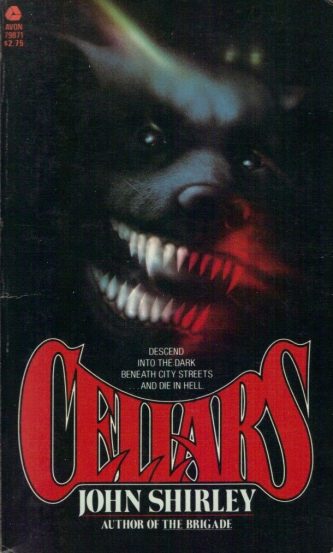CELLARS is far from author John Shirley’s best work, but is a headbanging blast nonetheless: it’s wild, it’s raw, it goes too far. If you’re wanting refinement you’d best look elsewhere, as Shirley packs enough concentrated grue and sheer intensity into his 295 pages to make CELLARS seem every bit as transgressive today as when it first appeared.
Back in 1982 readers weren’t ready for this novel—The Twilight Zone Magazine called it “a declaration of war on all standards of taste within the genre”—but now, nearly 30 years later, CELLARS can take its rightful place as a forerunner of the work of guys like John Skipp, Clive Barker (whose BOOKS OF BLOOD story “The Midnight Meat Train” contains many similarities to CELLARS) and Ed Lee. The latter, incidentally, penned an introduction to a revised edition of this book, which may or may not rectify the shortcomings of the original publication.
John Shirley has been publishing steadily since the 1970s. His novels tend to be extremely weird and, even more damaging from a commercial standpoint, nearly always ahead of their time. I guess this is why he’s currently stuck cranking out movie novelizations and paperback series novels while guys like Barker and William Gibson can write their own tickets—and yet Gibson has acknowledged the influence of Shirley’s novels TRANSMANIACON and CITY COME A-WALKIN’ on his own work, just as CELLARS laid the groundwork for the splatterpunks.
The novel centers on journalist Carl Lanyard, a onetime psychic and current newcomer to the pre-gentrified mean streets of NYC’s Alphabet City. As Shirley describes it, back in the early eighties the place was a nightmare of street tramps, burned-out buildings and, most horrific of all, scads of yuppies-in-training.
Lanyard is recruited by the NYPD to investigate a series of gruesome murders taking place in subway tunnels. It seems that a malevolent cult is responsible for the killings, committed as sacrifices to an obscure Egyptian deity.
Things get weirder when children around the area begin to disappear and Lanyard’s psychic powers return, causing him to visualize crawling things in the air around him. This being a Shirley story, there are some truly strange elements, like the slime creature that sucks people down tiny drains and the rundown subway car that’s opulently refurbished on the inside with a carpet, couch and chandelier.
Okay, CELLARS has some definite flaws. This was Shirley’s sixth novel and his first foray into hard-core horror (the superior IN DARKNESS WAITING and WETBONES would follow). It remains one of his more problematic works.
Shirley’s first five novels were (despite their crudeness) fast and lean, while CELLARS feels bloated and overwritten, with certain adjectives used over and over (try and count how many times “gingerly” is employed). Shirley admittedly writes extremely fast (he’s claimed it takes him an average of three weeks to knock out a novel) and it shows.
But do keep in mind that nothing else like this was being written at the time. Whatever you might think of CELLARS, it will provoke a reaction, and doubtlessly a strong one. Even working below par, John Shirley’s work is still more potent than just about anything else around.

